
Orvieto is a city and comune in the Province of Terni, southwestern Umbria, Italy, situated on the flat summit of a large butte of volcanic tuff. The city rises dramatically above the almost-vertical faces of tuff cliffs that are completed by defensive walls built of the same stone.

Palazzo dei Papi is a palace in Viterbo, northern Latium, Italy. It is considered to be one of the most important monuments in the city, situated alongside the Duomo di Viterbo. The Papal Curia was moved to Viterbo in 1257 by Alexander IV, due to the hostility of the Roman commune and constant urban violence: the former bishop's palace of Viterbo was enlarged to provide the Popes with an adequate residence. The construction, commissioned by the Capitano del popolo Raniero Gatti, provided a great audience hall communicating with a loggia raised on a barrel vault above the city street. It was completed probably around 1266.
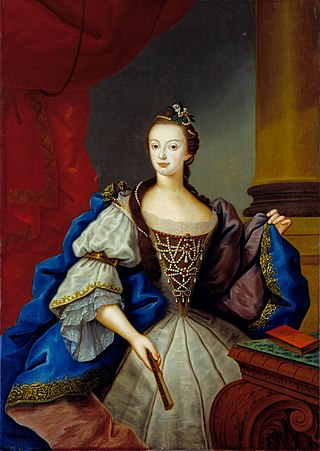
The Palace of Queluz is an 18th-century palace located at Queluz, a city of the Sintra Municipality, in the Lisbon District, on the Portuguese Riviera. One of the last great Rococo buildings to be designed in Europe, the palace was conceived as a summer retreat for King Joseph I's brother, Peter of Braganza, later to become husband and king jure uxoris to his own niece, Queen Maria I. It eventually served as a discreet place of incarceration for Maria I, when she became afflicted by severe mental illness in the years following Peter III's death in 1786. Following the destruction of the Palace of Ajuda by fire in 1794, Queluz Palace became the official residence of the Portuguese Prince Regent John, and his family, and remained so until the royal family fled to the Portuguese colony of Brazil, following the French invasion of Portugal (1807).

Orvieto Cathedral is a large 14th-century Roman Catholic cathedral dedicated to the Assumption of the Virgin Mary and situated in the town of Orvieto in Umbria, central Italy. Since 1986, the cathedral in Orvieto has been the episcopal seat of the former Diocese of Todi as well.

The Palazzo di Propaganda Fide is a palace located in Rome, designed by Gian Lorenzo Bernini, then Francesco Borromini. Since 1626, it has housed the Congregation for the Evangelization of Peoples and since 1929 is an extraterritorial property of the Holy See. The complex includes a dormitory and chapel as well.

The Zecca is a sixteenth-century building in Venice, Italy which once housed the mint of the Republic of Venice. Built between 1536 and 1548, the heavily rusticated stone structure, originally with only two floors, was designed by Jacopo Sansovino in place of an earlier mint specifically to ensure safety from fire and to provide adequate security for the silver and gold deposits. Giorgio Vasari considered it the finest, richest, and strongest of Sansovino's buildings.

The Palazzo dei Consoli is a Gothic architecture, civic building in the historic center of Gubbio, region of Umbria, Italy. Construction took place during 1332–1349 under design by Angelo da Orvieto; the palace was built on a large platform built against the hillside and looming over the town below.
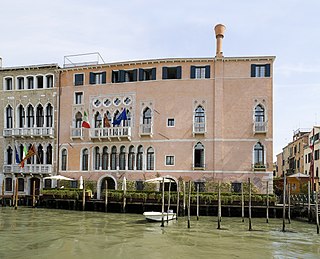
The Ca' Sagredo is a 14th-century Byzantine-Gothic style palace located on the corner of the Strada Nuova and Campo Santa Sofia, in the sestiere of Cannaregio in central Venice, Italy. It now faces the Grand Canal (Venice), and across the campo from the Ca' Foscari. On the left side there is the Palazzo Giustinian Pesaro.

The Villa Gallarati Scotti is a rural palace located near the town of Vimercate, in the Province of Monza and Brianza, in the Region of Lombardy, Italy.
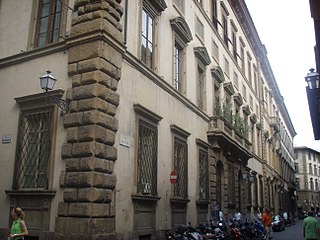
The Palazzo Pucci is a palace located at Via dei Pucci 4 in central Florence in the region of Tuscany, Italy. The façade of the palace spans from Via dei Servi to Via Ricasoli.

The Pavillon de Marsan or Marsan Pavilion was built in the 1660s as the northern end of the Tuileries Palace in Paris, and reconstructed in the 1870s after the Tuileries burned down at the end of the Paris Commune. Following the completion of the joining of the Louvre and the Tuileries in the 1850s and the demolition of the Tuileries' remains in the early 1880s, it is now the northwestern tip of the Louvre Palace. Since 1897 it has been part of the Musée des Arts Décoratifs, a separate institution from the Louvre.

Palazzo Gambacorti is a Gothic-style former aristocratic palace, located in Lungarno Gambacorti #1 corner with Piazza XX Settembre, near the spot the Ponte the Mezzo crosses over to the South bank of the Arno, in the historic center of Pisa, region of Tuscany, Italy. It is connected through the second floor of the white marble Loggia di Banchi, once the town archive. The palace is now houses the city council meetings in its Sala delle Baleari.
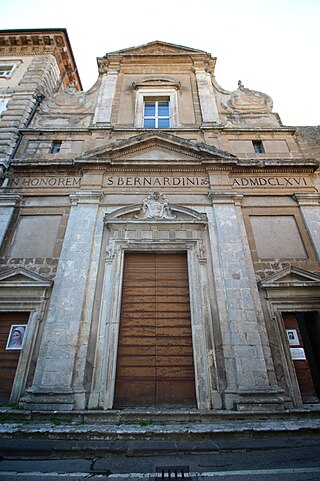
San Bernardino is a Baroque architecture, Roman Catholic church on 8 via Soliana, corner with via Cesare Nebbia, in Orvieto, region of Umbria, Italy.
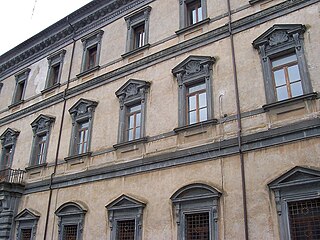
Palazzo Clementini is a Renaissance architecture, aristocratic palace located on Piazza Ippolito Scalza in the historic center of Orvieto in the Region of Umbria, Italy. To the left (North) of the palace is the church of San Giuseppe e Giacomo. The building houses the Liceo Classico Filippo Antonio Gualterio.

The Museo Claudio Faina is an archeologic museum located in the Palazzo Faina, across the piazza from the north side of the facade of the Duomo in Orvieto, region of Umbria, Italy.

The Palazzo Monaldeschi, known also as Palazzo Sforza Monaldeschi della Cervara or as Palazzo Marsciano or Meoni or, is a Renaissance architecture, aristocratic palace located on Piazza Ippolito Scalza in the historic center of Orvieto in the Region of Umbria, Italy. It is located about a block north of the church of San Francesco on Via Beato Angelico #52, corner with Via di Maurizio.

Palazzo Crispo Marsciano, previously known simply as the Palazzo Marsciano is a Renaissance architecture palace located on Via Postierla #9 on Piazza Marconi in the historic center of Orvieto in the region of Umbria, Italy.

San Giacomo Maggiore is a Neoclassical architecture, Roman Catholic church located on Piazza del Duomo #10, with a facade facing north to the cathedral piazza, just to the west of Palazzo Soliano, and adjacent to the former hospital of Santa Maria della Stella, in Orvieto, region of Umbria, Italy.

The Palazzo Comunale, once called Palazzo Municipale is a Mannerist architecture civic palace located in Piazza della Republica, adjacent to the dodecagonal bell-tower of the church of Sant'Andrea in the historic center of Orvieto, region of Umbria, Italy. The palace houses city hall offices.

The Palazzo dei Sette, also called Palazzo per il Tribunale, Palazzo Apostolico, and Casa del Papa is a Renaissance architecture palace located in Corso Cavour#85, almost central to the upper historic city of Orvieto, region of Umbria, Italy. Adjacent to the palace is the square medieval Torre del Moro which, after climbing its 300 stairs, affords a view of the rest of the town and surrounding countryside.




















